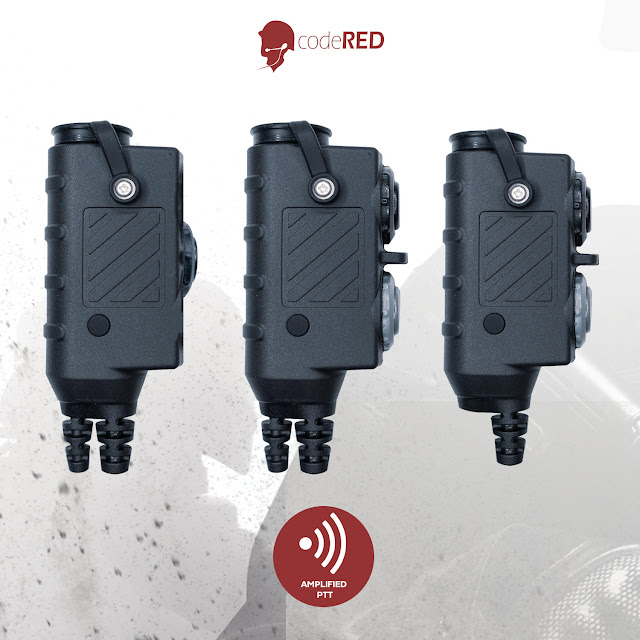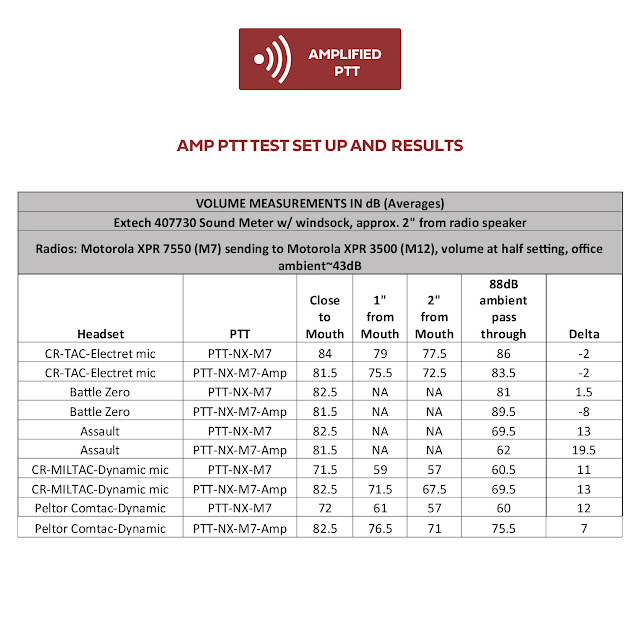If you are familiar with Tactical Headsets, you are very familiar with Tactical PTTs. What you may not be so intimate with is the function and utility of an amplified PTT. At this point a refresher course on Boom Mics and High Noise Headsets would be a good idea (see previous Technical Bulletins archive in our Blog listing). We will cover these topics here in broad brush strokes, but if you crave more detail I would suggest going back to those previous articles.
BOOM MIC BASICS
Boom Mics come in two basic flavors: Electret Mics and Dynamic Mics. Which one is best for your application will be a matter of preference, but if you are in sustained high noise environments, a Dynamic Mic is the best choice. An electret mic will give better clarity and sensitivity to your voice making transmission more accurate. These types of mics will also pick up ambient sounds much easier, so this may confuse your transmissions. A Dynamic Mic requires you to talk directly into it with some additional force and purpose. As you move the boom mic away from your mouth, the level of transmission will drop off quickly. This feature helps a dynamic mic negate, or ignore, ambient sounds, allowing your voice to dominate the transmission. This is a good thing usually, but it will not really allow you to communicate with a whisper.
We have included data from Bone Conduction mics and Throat Mics here, but the topic of amplified mics is really a dynamic mic concern. Many users are looking for a dynamic mic that acts like an electret mic under low noise situations but acts like a dynamic mic when the sound levels go up.
AMPLIFIED PTTs
As reviewed above, dynamic mics negate a considerable amount of sound input. They require additional “activation energy” to transmit. This just means that you must speak louder into them. The beauty of a dynamic mic is that it will not transmit loud ambient noise, which will enable you to get your communication across even in high noise situations. Amplifying the mic circuit will amplify the transmission so your communications will come through at a higher level, but the ambient sound will be amplified as well. We decided to do some real-world testing using our legacy electret mics and compare them to the performance of our new dynamic boom mic on the CR-MILTAC (also an option on the CR-TAC).
We also used the venerable 3M Peltor Comtac with dynamic mic as comparison to what is probably the most common headset used by tactical professionals in our nation’s SWAT teams.
We also looked at transmission with our Battle Zero bone conduction headset and the Assault throat mic, both of which had very interesting results.
THE TEST SET UP
We tested all the headsets in the spreadsheet below using the same test parameters. The same radios, and the same PTTs set to the exact same volumes, in the exact same office environment (43 dB). The same sound meter was used and the distance from the radio mic was measured in all tests. The radios we used are professional models, but not on the crazy end of the cost spectrum. Motorola XPR professional radios are a little more costly than a typical consumer model, at $300-$500, but still reasonable compared to the $5k units law enforcement uses. These professional grade radios, like the XPR, tend to have better performance and generate better transmission signals than some of the low-cost consumer grade radios, including the Motorola consumer models.
The 2 PTTs we used were the NX series PTT with our M7 connector. One was our existing unamplified model, the other is our new amplified version of the same PTT. The amplified version is set to launch this month and we will be sending out announcements on social media as well as on our website.
For boom mic testing we measured transmission with the boom mic up against the user’s mouth, 1” away, and 2” away to simulate various use models and to demonstrate how a dynamic mic will have different performance than an electret mic in the same situations.
We also measured each set up in a high noise situation. To create this situation, we keyed up the PTT approximately 2 feet away from a running air compressor. At this point the ambient noise was measured as 88dB. We then measured how much of that sound was transmitted through the radio to a receiving radio located in a separate room.
The results are actually “averages” based on observed sound levels. We did this because a typical sound measurement is fairly erratic and has peaks and valleys. An average is a better representation of the sound level coming through.
With these results we were able to calculate a “Delta” signal: the difference between the signal generated with the boom mic close to the mouth minus the “pass through” ambient sound from the compressor. These results were the most interesting in my opinion.
TEST SET UP AND RESULTS
RESULTS ANALYSIS
- Most of the results were exactly what you would expect, but there were some surprises. For example, the throat mic performed very well in all scenarios. It seemed to be a better choice for high noise situations than we had anticipated. Below is a summary of the results in bulleted statement format, refer to the raw data above for verification.
- The amplified PTT increased the sound level of the transmission on the dynamic mics (Peltor, CR-MILTAC), which is what it is supposed to do.
- For the electret mic, bone conduction mic and throat mic the amplified PTT slightly decreased the transmission, but not so much to render it a problem.
- The amplified PTT increased the pass-through sound of the high noise (compressor) in every case except the throat mic. This result was not expected, and we even repeated the test to confirm what we were seeing. We are still discussing why this is happening.
- The Delta signal (subtracting transmission from ambient sound pass through) was very poor for the bone conduction mic and electret mic. These are not good choices, regardless of PTT, for high noise situations.
- The dynamic mic worked very well with both the standard PTT and the amplified PTT. This is a good set up for high noise situations. It is interesting to note the performance in high noise situations was very good even without amplification. The amplified PTT shows its benefit in low ambient noise transmission situations, it amplified the sound about 10 dBs (see MILTAC data for std PTT and Amp PTT).
- The throat mic performed very well with both PTTs and had very low ambient sound transmission. This created a Delta signal that was higher than all other combinations. This seems to be an excellent choice, as good as or better than dual earmuff headsets (CR-MILTAC and Peltor). Really the surprise result for this series of tests.
- It is also interesting to note that our CR-MILTAC with dynamic mic performed very similar to the Peltor Comtac using our NX PTT.
CONCLUSIONS
Amplified PTTs are great. They amplify the transmission of dynamic mics in low sound applications without having too much of an adverse effect on high noise pass through situations. Although they will still work well with electret mics (CR-TAC, Battle Zero and Assault throat mic) their benefit is not very noticeable. Electret boom mics and bone conduction mics are not a good choice for high noise situations. Throat mics appear to work very well in ALL situations. This is probably why there is a rabid group of throat mic loyalists out there.
We believe we have a good addition to our tactical PTT offering with the new Amplified NX PTT line. Look for them to be available in August 2022 for use with our NX and Pro series headsets in our K, K-B, M, and M7 connectors and others using various adapters.
THANKS FOR READING!
codeRed Tech Support
Find codeRED NX Amplified PTTs available at www.coderedheadsets.com


